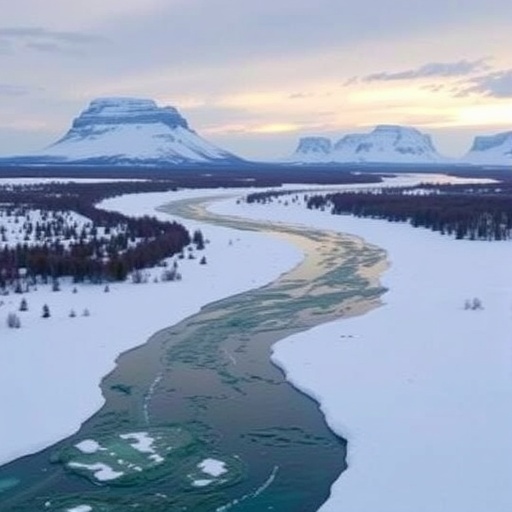In the rapidly warming Arctic, an alarming shift is occurring beneath the surface of its vast network of rivers, fundamentally altering the chemical composition of essential nutrients that underpin marine ecosystems. New research reveals that the six largest Arctic rivers—the Yenisey, Lena, Ob’, Mackenzie, Yukon, and Kolyma—are transporting significantly less inorganic nitrogen, a critical nutrient for aquatic life, to the Arctic Ocean. This transformation threatens the delicate balance of coastal food webs and the communities that depend on them for millennia.
Conducted by Bridger J. Ruyle of NYU Tandon School of Engineering and his colleagues, this groundbreaking study utilized two decades of robust data to decipher the complex interactions between climate change and river chemistry. Published in the prestigious journal Global Biogeochemical Cycles, the research dissects the intricate roles of rising temperatures and thawing permafrost in driving these dramatic changes. Ruyle, who led the research during his postdoctoral tenure at the Carnegie Institution for Science, emphasizes that the consequences extend far beyond mere nutrient availability—they signify a potentially irreversible disruption of Arctic marine ecosystems.
Arctic rivers have long been vital arteries, funneling nitrogen that fuels up to 66% of primary production in coastal marine environments. This nitrogen primarily arrives in an inorganic form, readily bioavailable to phytoplankton—the microscopic plants forming the base of the ocean’s food chain. However, recent observations indicate a troubling decline in inorganic nitrogen concentrations between 2003 and 2023 across four of the six major rivers studied. Concurrently, the rivers exhibited substantial increases in dissolved organic nitrogen, which is much less accessible to marine organisms and thus less effective in supporting biological productivity.
The shift in nitrogen composition is a multifaceted consequence of climatic shifts. Rising air temperatures accelerate permafrost thaw, releasing previously trapped organic matter into river systems. Warmer climates also alter precipitation patterns, affecting river discharge volumes and chemistry. These environmental changes collectively transform the pathway and form of nitrogen transport, underpinning the observed increase in organic nitrogen forms that marine ecosystems struggle to utilize efficiently.
Ruyle and his team employed sophisticated statistical modeling that integrated 20 years of extensive water chemistry data with environmental variables, such as temperature, precipitation, land cover, and permafrost extent. Their analysis pinpointed permafrost loss as the most critical factor influencing the divergent trends between organic and inorganic nitrogen. This finding underscores how the degradation of permafrost—a defining feature of the Arctic landscape—is reshaping not only terrestrial habitats but also aquatic biogeochemical cycles that support marine life.
The consequences of these biochemical alterations propagate through the Arctic food web in complex and potentially devastating ways. Coastal Indigenous communities, whose subsistence lifestyles have depended on the predictable productivity of these ecosystems, face uncertainty as the foundational nutrient supply fluctuates. Reduced availability of inorganic nitrogen could compromise the growth of phytoplankton, triggering a cascade that affects fish populations, marine mammals, and human societies alike.
Beyond the Arctic, Ruyle’s broader research mission interrogates the intertwined impacts of human activity, climate change, and natural processes on global water quality. His work extends to tracking persistent environmental contaminants such as PFAS—commonly known as “forever chemicals”—and pharmaceuticals in wastewater systems. These studies reveal parallel concerns about how shifting environmental conditions amplify water contamination risks, especially where dilution effects diminish during droughts, compounding threats to ecological and human health.
This Arctic-focused research delineates a crucial link between nitrogen dynamics in river systems and broader global environmental challenges. By demonstrating how temperature fluctuations and precipitation changes directly cascade through complex biogeochemical systems, the study adds urgent nuance to our understanding of climate change’s pervasive impact. The findings challenge scientists and policymakers to reconsider water quality and climate change as inseparable issues demanding integrated monitoring and management strategies.
Ruyle highlights the importance of advancing analytical tools and modeling capabilities that combine remote sensing with ground-based data to better predict and mitigate the impacts of climate change on water quality. Enhanced understanding of these mechanisms is essential for developing adaptive strategies to safeguard marine ecosystems and the human populations reliant on them, particularly in fragile Arctic regions where changes occur at ecosystem and cultural frontiers.
The interdisciplinary collaboration behind this research reflects a convergence of expertise across institutions and continents. Alongside Ruyle, contributors include Julian Merder from the University of Canterbury, Robert G.M. Spencer from Florida State University, James W. McClelland from the Marine Biological Laboratory, Suzanne E. Tank from the University of Alberta, and Anna M. Michalak from the Carnegie Institution for Science. Their combined insights illuminate the comprehensive scope of the study’s data collection and interpretation.
Funded by the National Science Foundation through grants supporting the Arctic Great Rivers Observatory, this work exemplifies the vital role of international scientific cooperation in addressing the urgent environmental challenges posed by climate change. As the Arctic continues to serve as a sentinel for global environmental shifts, studies like this provide indispensable knowledge needed to craft effective, forward-looking ecological and social policies.
Ruyle’s assertion that water quality and climate change are fundamentally linked resonates throughout the findings. With the Arctic experiencing some of the fastest climatic transformations on Earth, understanding these interconnections is critical. Without effective intervention and enhanced scientific insight, the nutrient impoverishment of Arctic rivers risks triggering ecological decline that could ripple through global systems, underscoring the urgent call to action embedded in this research.
Subject of Research: Not applicable
Article Title: Changes in the Composition of Nitrogen Yields in Large Arctic Rivers Linked to Temperature and Precipitation
News Publication Date: 24-Jul-2025
Web References:
References:
Ruyle, B.J., Merder, J., Spencer, R.G.M., McClelland, J.W., Tank, S.E., Michalak, A.M. (2025). Changes in the Composition of Nitrogen Yields in Large Arctic Rivers Linked to Temperature and Precipitation. Global Biogeochemical Cycles. https://doi.org/10.1029/2025GB008639
Keywords:
Climate change effects, Ecosystems, Arctic Rivers, Nitrogen Cycling, Permafrost Thaw, Biogeochemical Cycles, Water Quality, Marine Ecosystems, Climate Adaptation




